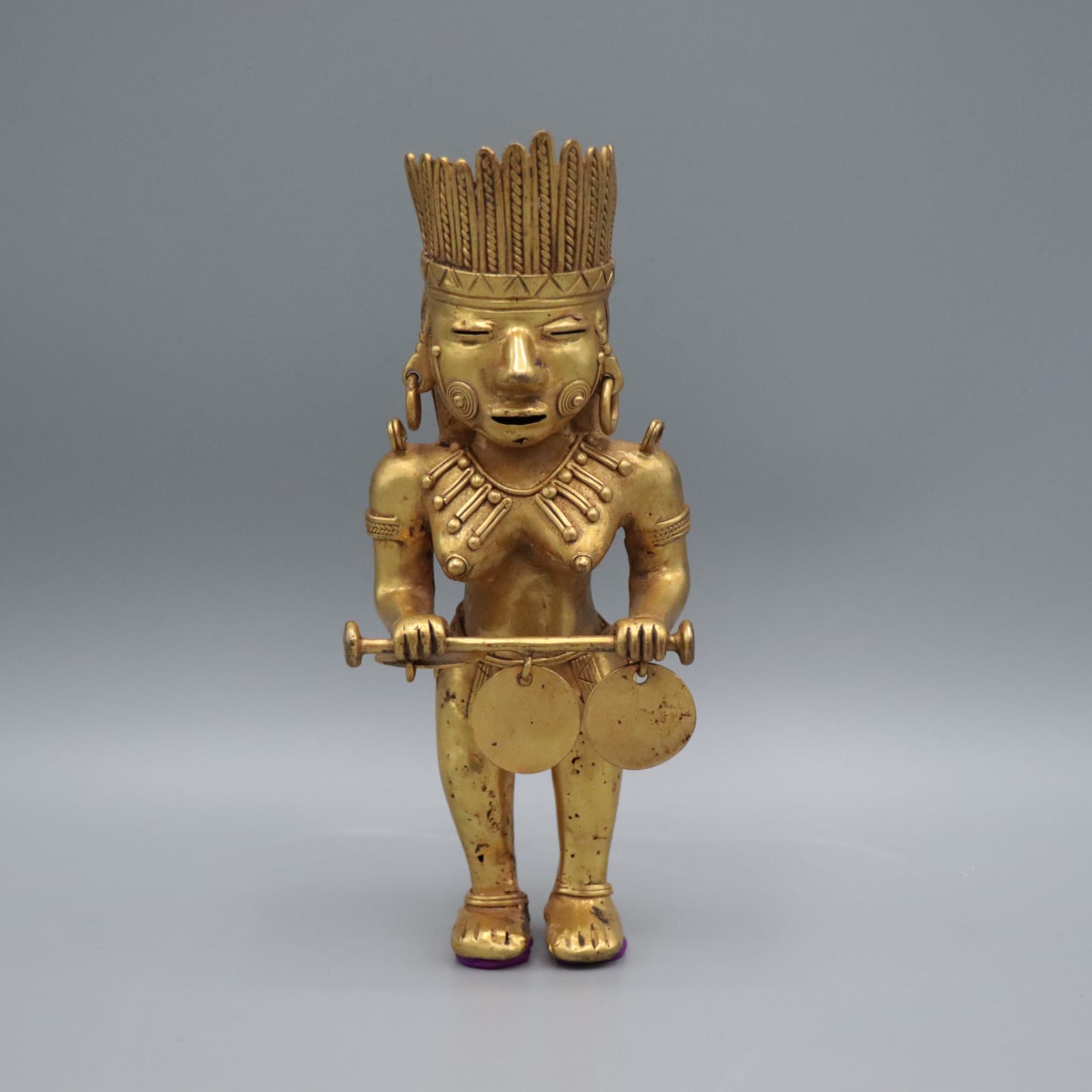Tairona Gold Female Figure, 10th to 15th century CE
height 17.5 cm
height 6 7/8 in
height 6 7/8 in
LI.3243
An exceptionally powerful Tairona gold figure portraying a woman with a ritual implement. The female is richly adorned with a complex necklace, earrings, and armbands. She wears a beautiful headpiece...
An exceptionally powerful Tairona gold figure portraying a woman with a ritual implement. The female is richly adorned with a complex necklace, earrings, and armbands. She wears a beautiful headpiece with a band adorned with geometric patterns. The statuette was realised through the use of the lost wax technique and as such preserved a light and yet solid presence.
At the time of the Spanish Conquest of the Americas, in the Sierra Nevada mountain chain of northern Colombia, a lively metallurgical tradition was alive among the Chibcha-speaking Tairona. The Tairona culture began their process of consolidation as a social and political entity in the first centuries after Chirst, reaching their apex of development after 1000 A.D. when dense populations were grouped together in many urban centers. Today, over two hundred Tairona sites are known, ranging from the coastal lowlands to the heights of the mountains. Settlements of varying sizes reflect a hierarchical political order; several large centers controlled numerous smaller ones, through a chiefly and priestly elite.
Tairona goldwork reveals a complex iconography often combining both animal and human features. The Kogi people of the Sierra Nevadas, modern descendents of the Tairona, do not value gold, or other metal and gems for that matter, as indicators of wealth and personal prestige. For them, gold is a symbol of potential fertility belonging to all members of their society. The sun, the penultimate procreating force, transmits its power to gold, presumably endowing the metal with its yellowish hue. We can presume that the Tairona originally viewed gold much the same way, as ornaments charged with potent symbolism relating to the continuation of life. Perhaps this idea of gold as a fertile force is no better embodied than in this spectacular sculptural pendant representing a nude woman.
At the time of the Spanish Conquest of the Americas, in the Sierra Nevada mountain chain of northern Colombia, a lively metallurgical tradition was alive among the Chibcha-speaking Tairona. The Tairona culture began their process of consolidation as a social and political entity in the first centuries after Chirst, reaching their apex of development after 1000 A.D. when dense populations were grouped together in many urban centers. Today, over two hundred Tairona sites are known, ranging from the coastal lowlands to the heights of the mountains. Settlements of varying sizes reflect a hierarchical political order; several large centers controlled numerous smaller ones, through a chiefly and priestly elite.
Tairona goldwork reveals a complex iconography often combining both animal and human features. The Kogi people of the Sierra Nevadas, modern descendents of the Tairona, do not value gold, or other metal and gems for that matter, as indicators of wealth and personal prestige. For them, gold is a symbol of potential fertility belonging to all members of their society. The sun, the penultimate procreating force, transmits its power to gold, presumably endowing the metal with its yellowish hue. We can presume that the Tairona originally viewed gold much the same way, as ornaments charged with potent symbolism relating to the continuation of life. Perhaps this idea of gold as a fertile force is no better embodied than in this spectacular sculptural pendant representing a nude woman.
